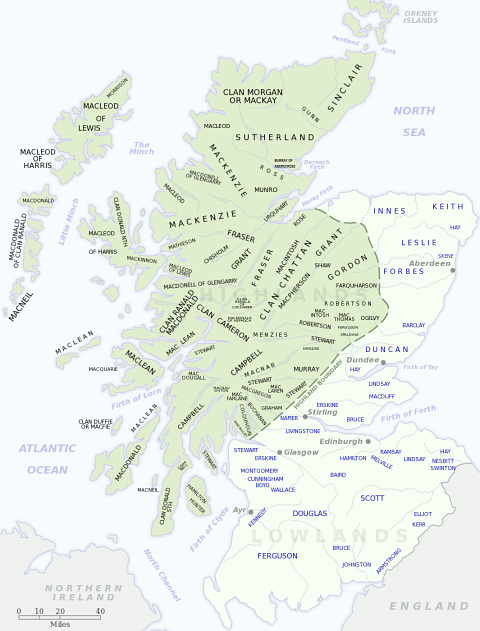
Motto: Deus juvat (God assists)
Historic Seat: MacDuff's Castle
District: Fife
Associated Surnames: Duff, Duffie, Duffy, Fife, Fyfe, Kilgour, Spence
Associated Tartans:
Early MacDuff Genealogy and History:
(Excerpt from "The Scottish Clans and Their Tartans", James Grant, 1906)
The origin of this tribe, of which the old Marmaers and afterwards Earls of Fife were head, is clouded by fable; but the first of whom there is any distinct trace is that Earl of Fife who is said to have slain MacBeth, and whom, according to Fordoun, Malcolm III rewarded by according to his family the honour of placing the sovereign on the throne, with the leading of the army, and the sanctuary, afforded by the famous Girth cross of MacDuff, of which, we believe, only the socket stone is seen on the Ochil range now.
His son Gillemichel, is probably the first in whom the Earldom became hereditary. He died in 1139, and was succeeded by his son Duncan, who was at one time Regent of Scotland, and died 1154. His son Duncan, third Earl, was Justiciary of Scotland, and dying 1203 was succeeded by his son Malcolm, who founded the Abbey of Culross in 1217. He died without issue in 1228, and was succeeded by the son of his brother Duncan - Malcolm, fifth Earl, who was one of the Guardians of Scotland. He died 1266, and his son Colbran, died 1270, and was succeeded by his son Duncan, seventh Earl, who was murdered in 1288.
His son Duncan first sided with the English, then with Robert Bruce, and being taken prisoner at the battle of Dupplin1 in 1332, he submitted to Edward Baliol. In the long run he changed sides once more and joined King David II. He was again taken prisoner at Durham in 1346, condemned as a traitor, was pardoned, and eventually died without male issue in 1353. He was succeeded by his daughter Isabel who married first William Ramsay of Colluthie, who in her right became Earl of Fife. The Countess afterwards married Walter, son of King Robert II, Sir Thomas Byset, and John de Dunbar, but left no issue.
"There were several cadets of the MacDuffs, Earls of Fife," says Sir Robert Sibbald, "viz., the predecessors of the Earls of Wemyss, of MacIntosh of Tosach, of Monyvaird, of the Barons of Finday, Craigton, and others of the name of Duff."
Among the missing charter of Robert III is one to David Duff of the lands of Maldakatu and Baldavy, in the shire of Banff. In the Register of the Privy Council, under date 1586, are some entries with reference to a feud between the MacDuffs of Strathbraan and of Fandowie, who seem to have had a quarrel among themselves.
In 1600 John MacDuff, otherwise Ferguson, of Fandowie, in Atholl, was executed for his share in the Gowrie conspiracy2.
David Duff, an alleged descendant of the last Earl of Fife, received from Robert III, in 1401, a considerable grant of land, and of the Barony of Muldavit, which continued to be one of the chief titles of the family until alienated in the reign of Charles II.
Adam Duff in Cluniebeg was the father of Alexander Duff of Keithmore, whose eldest son was Alexander Duff of Braco, M.P.3 for Banffshire 1707, and his second son William "was elevated to the Peerage of Ireland by the Queen Regent Caroline as Baron Braco of Kilbryde, 28th July 1735, and advanced to a Viscounty and Earldom, 26th April 1759, by the titles of Viscount MacDuff and Earl of Fife."
He was twice married; first to Janet Ogilvie, daughter of James, Earl of Findlater and Seafield; but by her had no issue. He married, secondly, Jane, daughter of Sir James Grant of Grant, Bart.4 Four of their children all died unmarried, but he was succeeded at his death in 1763 by his son James, second Earl of Fife, who in 1790 was created a Peer of Great Britain.
The second Earl died in 1809, and was succeeded by his brother Alexander, third Earl, father of James, fourth Earl, who died without issues in 1857; when the title devolved on his nephew James, fifth Earl; he died in 1879, and was succeeded by his son Alexander, sixth Earl, who, in 1889, on his marriage with the Princess Louise of Wales, was created Duke of Fife, with remainder to his male issue. Having no son, he was again created Duke of Fife in 1900, with remainder to his daughters.
(End excerpt)
Next page: Clan MacFarlane
Footnotes:
1The Battle of Dupplin Moor (1332): The Battle of Dupplin Moor was fought 10-11 August, 1332, near Perth, Scotland between supporters of the infant David II, son of Robert the Bruce, and rebels supporting the Baliol claim to the throne. It was a significant battle of the Second War of Scottish Independence. Read more about the Battle of Dupplin Moor at Wikipedia.
2 Gowrie conspiracy: A conspiracy led by John Ruthven, 3rd Earl of Gowrie, in which there was an attempt to kill or kidnap King James VI of Scotland. Read more about the Gowrie conspiracy at Wikipedia.
3 M.P.: Member of Parliament
4 Bart.: Baronet

Distribution of Scottish clans and families
View larger map at Wikimedia Commons

Browse the Clan MacDuff Tartan Collection with home decor, personal accessories, crafting, paper products, and more.

Browse the Clan MacDuff Dress Tartan Collection with clothing, home decor, accessories, electronics cases, and more.

Clan MacDuff Postcard: Digitally cleaned and enhanced vintage illustration with tartan border.